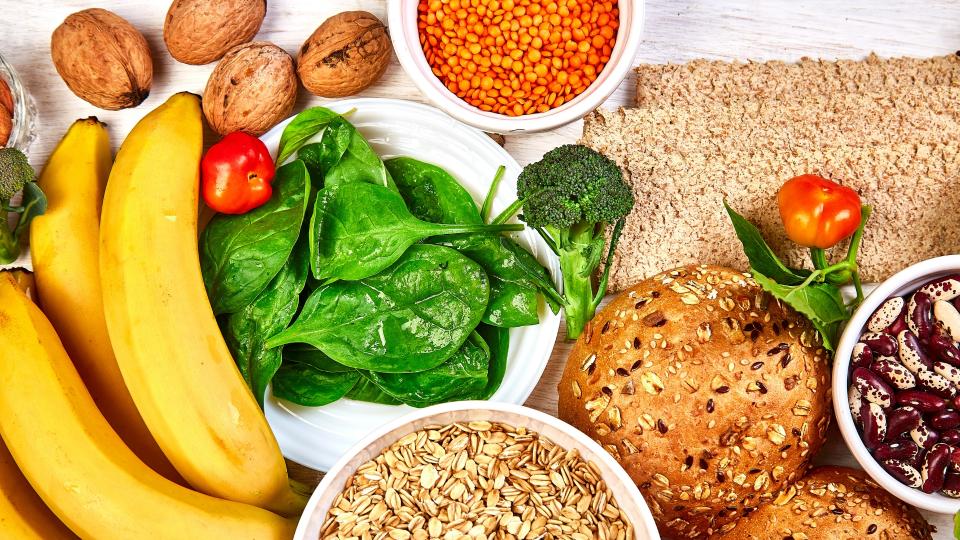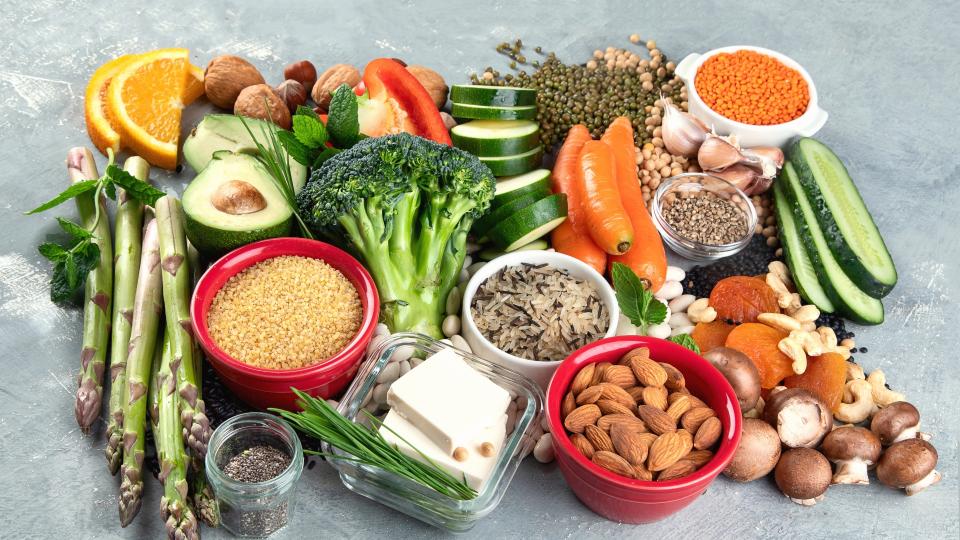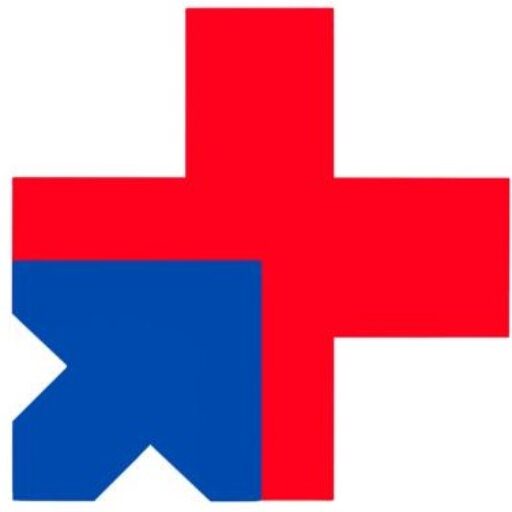A high fiber diet – sounds simple, right? But what exactly does it entail, and why is it so crucial for a fit and fabulous lifestyle?
Dietary fiber refers to the parts of plant foods that your body can’t absorb or digest. It’s these components that help maintain optimal health, especially for busy individuals always on the go.
In this article, we’ll dive into the significance of a high fiber diet and share practical hacks to boost your intake, even within a busy schedule.
So whether you’re a corporate climber or a hustling entrepreneur, keep reading to discover how you can easily incorporate more fiber into your day!
Understanding Dietary Fiber

When you hear the term dietary fiber, you might think of bran muffins or cereal. But there’s so much more to it!
Dietary fiber is a plant-based nutrient that passes through our digestive system without being digested.
It’s essential for maintaining a robust and healthy body, but before we dive into its benefits, let’s understand its types.
Types of Dietary Fiber
- Soluble fiber. This type of fiber absorbs water and turns into a gel-like substance during digestion. It’s found in foods like oranges, apples, carrots, potatoes, peas, beans, oats, and barley.
- Insoluble fiber. Unlike soluble fiber, insoluble fiber doesn’t dissolve or change form as it travels through our system. You can find it in brown rice, wholemeal bread, fruit skins, nuts, seeds, and cereals.
Now that you know the difference between soluble and insoluble fibers, you might wonder why they matter. The answer lies in the long list of health benefits they offer:
- Promoting regular bowel movements
- Managing weight by slowing down food intake
- Helping control blood sugar levels by steady sugar release
- Interfering with bile reabsorption to keep cholesterol levels in check
So next time when you’re eating an apple or munching on some nuts – remember the fantastic health benefits they offer due to their high fiber content!
The Health Advantages of a High Fiber Diet

1. Promoting Digestive Health and Preventing Constipation
A fiber-rich diet helps our body by promoting regular bowel movements. How does it work? Fiber adds bulk to our diet, making it easier for food to move through the digestive tract.
This prevents constipation and keeps our digestive system healthy.
2. Facilitating Nutrient Absorption and Supporting Overall Well-being
Dietary fiber acts like a sponge, soaking up water as it moves through your digestive system. This slows down digestion, allowing your body to absorb vitamins and minerals more effectively.
Thus, these nutrients are essential for supporting your overall well-being.
3. Managing a Healthy Weight
Have you ever noticed that eating foods high in fiber makes you feel full for longer? That’s because dietary fiber expands in your stomach, helping you control your appetite and manage your weight.
4. Stabilizing Energy Levels and Reducing Risk of Type 2 Diabetes
High-fiber foods are digested slowly, which means they release glucose into your bloodstream at a steady pace.
This helps maintain stable energy levels throughout the day and reduces the risk of developing type 2 diabetes by improving blood sugar control.
5. Maintaining Heart Health through Cholesterol Regulation
Soluble fiber, in particular, is important for lowering cholesterol levels. It works by interfering with the re-absorption of bile in the body, which forces the liver to use more cholesterol to make new bile salts.
This leads to a decrease in overall cholesterol levels.
By now, it’s clear that a high-fiber diet is incredibly beneficial for our health.
But how much dietary fiber should we be consuming each day? Let’s find out in the next section.
Meeting the Recommended Daily Fiber Intake
In Singapore, adults are advised to consume a specific amount of fiber each day to maintain health and prevent disease.
The Singapore guidelines stipulate that women should aim for 20 grams of fiber daily, while men should target 26 grams.
Adhering to these benchmarks ensures that individuals receive enough fiber to support the body’s complex processes.
For Women: 20g of dietary fiber per day
For Men: 26g of dietary fiber per day
The significance of following these recommended daily intake levels lies in the numerous benefits fiber provides.
It not only contributes to a smoothly operating digestive system but also plays a role in warding off chronic conditions such as heart disease and diabetes.
By achieving the recommended intake, you’re taking an important step towards fortifying your body against potential health concerns and ensuring that you obtain the vital nutrients necessary for optimal functioning.
Top Sources of Dietary Fiber

Let’s explore the world of fiber-rich foods. The secret to meeting your daily fiber goal lies in three food groups: fruits, vegetables, and whole grains.
1. Fruits
Many fruits are packed with dietary fiber, especially when eaten with their skin. For example, apples and oranges each contain about 4 grams of fiber.
2. Vegetables
From peas to potatoes, vegetables are an excellent source of both soluble and insoluble fiber. Try adding a variety of colors to your meals to get the most nutritional benefits.
3. Whole Grains
Whole grains like brown rice, oats, and barley not only have more fiber than their refined counterparts but also provide many other essential nutrients. Consider swapping white rice or bread for whole grain options in your diet.
Remember, it’s important to have a variety!
Additionally, getting fiber from different sources ensures you enjoy the wide-ranging advantages of various types of fiber.
Read More: How to Add More Fruits into Your Diet
Practical Tips to Boost Fiber Intake in a Busy Lifestyle

Incorporating more fiber into your daily diet doesn’t have to feel like a chore.
Even with a busy schedule, there are simple and practical ways you can increase your intake.
1. Replace Refined Grains with Whole Grain Counterparts
For an easy start, consider shifting away from refined grains.
This means opting for brown rice instead of white rice, choosing wholegrain bread over white bread, and selecting wholegrain cereals, pasta, and flour when shopping for groceries.
2. Incorporate Traditional Local Dishes
Don’t forget about the local dishes! High-fiber hawker food such as popiah and rojak can be delicious additions to your meals.
These traditional dishes are not only tasty but also rich in dietary fiber.
3. Add Fruits and Veggies to Your Meals
Lastly, sneak in some extra nutrition by including fruits and vegetables into your meat dishes, soups, stews, or curries.
This way, you won’t just be adding color and flavor to your meals but also valuable fiber that nourishes the body.
Remember: boosting fiber intake is not about drastic changes but making smarter choices with what you eat. With these easy hacks, even the busiest individuals can enjoy a fiber-rich diet.
Lifestyle Factors for Optimal Fiber Utilization

Proper hydration is a must when increasing fiber intake. Dietary fiber, especially the soluble kind, absorbs water to help form a gel-like substance during digestion.
This process not only helps you feel full but also aids in the smooth passage of food through the gut.
Make sure to drink plenty of water throughout the day to facilitate this and prevent any potential discomfort such as bloating.
Engaging in regular physical activity is beneficial for your digestive system and complements a high-fiber diet.
Exercise promotes bowel movements by improving blood flow and muscle contractions in the gastrointestinal tract.
This combination of exercise and fiber can contribute to a healthy gut and reduce the risk of constipation, which is common when dietary changes are made.
Here are some simple lifestyle tips to support your fiber intake:
- Drink enough fluids, with water being the best choice.
- Incorporate physical activity into your daily routine, even short walks can make a difference.
By incorporating these lifestyle factors into a high-fiber diet, you create an environment for optimal digestion and overall health.
These habits, once established, will enhance your body’s ability to effectively utilize the fiber-rich foods you eat.
Read More: Motivation to Exercise: Surprising Ways to Keep It Going Strong
Delicious Recipes Packed with Fiber
Feeling hungry? Try these fiber-rich recipes that you can easily make anytime:
1. Fiber-Rich Breakfast Smoothie:
Start your day with a refreshing blend of fiber-rich fruits. Here’s what you’ll need:
- 1 banana
- 1 cup of spinach
- 1 tablespoon of chia seeds
- 1 cup of almond milk
- A handful of berries
Blend all the ingredients together until smooth and enjoy this nutritious powerhouse.
2. Quinoa Salad with Mixed Vegetables:
For lunch or dinner, try this simple yet satisfying quinoa salad. Here’s what you’ll need:
- Cooked quinoa
- Sliced bell peppers
- Diced cucumber
- Cherry tomatoes
- Some leafy greens
Toss everything together and dress it with a simple olive oil and lemon vinaigrette for a flavorful meal.
3. Lentil Soup:
Warm up with a bowl of hearty lentil soup. Here’s what you’ll need:
- Lentils
- Diced carrots, onions, and celery
- Vegetable broth
Simmer everything together until the lentils are tender. Season to taste and serve hot for a comforting dinner option.
Each of these meals not only provides a significant amount of fiber but also an array of other essential nutrients to keep you energized throughout your busy day.
Maintaining a Balanced Approach to Nutrition

While fiber is a superstar nutrient for digestion and overall health, it’s essential not to forget the chorus of other nutrients that play supporting roles in the body’s symphony.
Dietary diversity is key; it ensures you’re getting a rich array of vitamins and minerals necessary for optimal functioning. Here’s how to keep your plate harmoniously balanced:
- Incorporate Protein: Choose lean meats, fish, legumes, and dairy for muscle repair and immune function.
- Include Healthy Fats: Avocados, nuts, seeds, and olive oil contribute to heart health and aid in the absorption of fat-soluble vitamins.
- Vary Your Veggies: Aim for colorful plates – each hue represents different nutrients vital for maintaining good health.
Remember, focusing solely on fiber could lead to missing out on other crucial dietary components. Strive for balance with every meal.
Staying Consistent in the Long Run

Consistency is crucial when incorporating healthy habits like a high fiber diet into your life. Here are some practical tips to help you make high fiber food choices a regular part of your daily routine:
- Set Realistic Goals: Start with achievable targets, such as adding one extra serving of vegetables to your lunch or swapping out white rice for brown.
- Prepare in Advance: Use some of your weekend time to prepare fiber-rich snacks and meals for the upcoming week.
- Fiber at Every Meal: Make it a point to include at least one high-fiber food in every meal, whether it’s having a piece of fruit for breakfast or a side of legumes during dinner.
- Track Your Progress: Keep track of your fiber intake using a food diary or an app, and celebrate small wins along the way.
By incorporating these habits into your daily life, you’ll be able to establish a strong foundation for long-term change without feeling overwhelmed.
Seeking Professional Guidance If Needed

Sometimes, despite best efforts, you might find it challenging to meet your dietary fiber needs or have specific health concerns that require a tailored nutrition plan.
In such cases, consulting a registered dietitian or a healthcare provider is a wise step.
Additionally, they can offer personalized advice on your dietary needs, considering factors like your overall health status, any existing medical conditions, and your lifestyle habits.
- Consult a dietitian if you experience digestive troubles despite following a high-fiber diet.
- Visit your doctor if you have concerns about how fiber intake may interact with medications or medical conditions.
Remember, each individual is unique, and what works for one person may not work for another; professional guidance ensures that your journey towards better health through increased fiber intake is both safe and effective.
Conclusion
Incorporating high fiber into your daily routine may seem difficult, especially when you’re busy.
However, it’s important to remember that every small step matters!
Start by making simple changes like opting for whole fruits instead of juices, or choosing brown rice over white rice.
Your body will appreciate these healthy choices, and eventually, they will become second nature to you.
Remember to maintain a balanced diet. Along with fiber-rich foods, make sure to include a variety of proteins, healthy fats, and other essential nutrients in your meals.
Stay committed, stay hydrated, and keep active. Over time, you will experience the positive impact that dietary fiber has on your overall health and well-being.


